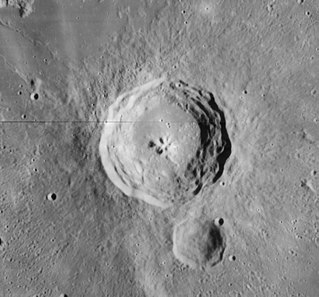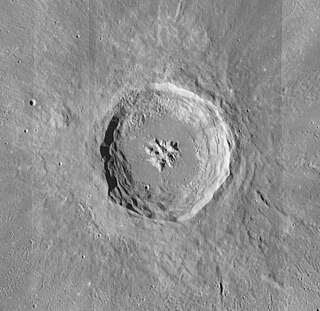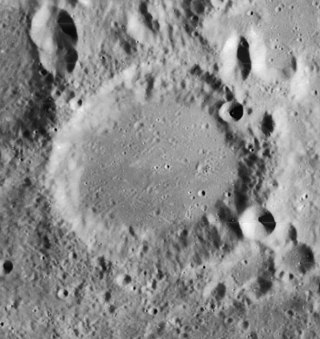
Arzachel is a relatively young lunar impact crater located in the highlands in the south-central part of the visible Moon, close to the zero meridian. It lies to the south of the crater Alphonsus, and together with Ptolemaeus further north the three form a prominent line of craters to the east of Mare Nubium. The smaller Alpetragius lies to the northwest, and Thebit is to the southwest along the edge of the mare.

Bullialdus is a lunar impact crater located in the western part of the Mare Nubium. It was named after French astronomer Ismaël Boulliau. To the north by north-west is the broken-rimmed and lava-flooded crater Lubiniezky. South-west of Bullialdus lies the smaller crater König.

Fabricius is a lunar impact crater that is located within the northeast part of the walled plain Janssen. Attached to the north-northwest rim is the slightly larger crater Metius. Fabricius has multiple central peaks that rise to 0.8 km, with a rugged rise to the northwest running north–south. The rim is lumpy and somewhat distended, most noticeably to the southwest and south. It is 78 kilometers in diameter and 2,500 meters deep. It is from the Eratosthenian period, 3.2 to 1.1 billion years ago. It is named after David Fabricius, a 16th-century German astronomer.

Metius is a lunar impact crater located in the rugged highlands to the southeast of the Moon's near side. To the southwest the rim is attached to the crater Fabricius. Offset to the west-northwest is the heavily worn crater Brenner. Further away to the northeast is the crater Rheita and the long gorge Vallis Rheita.

Piccolomini is a prominent lunar impact crater located in the southeastern sector of the Moon. The crater is named after 16th century Italian Archbishop and astronomer Alessandro Piccolomini. The crater Rothmann lies to the west-southwest, and to the south is Stiborius. The lengthy Rupes Altai begins at the western rim of Piccolomini, curving to the northwest. It is 88 kilometers in diameter and 4,500 meters deep. It is from the Upper Imbrian period, 3.8 to 3.2 billion years ago.

Rheita is a lunar impact crater located in the southwestern sector of the Moon. It was named after Czech astronomer and optician Anton Maria Schyrleus of Rheita. It lies to the northeast of the crater Metius, and northwest of Young. The southwestern rim overlies the edge of Vallis Rheita, a long lunar valley stretching for over 200 kilometers on a line running northeast to southwest. At its widest the valley is 25 kilometers wide and a kilometer deep.

Euler is a lunar impact crater located in the southern half of the Mare Imbrium, and is named after the Swiss mathematician, physician and astronomer Leonhard Euler. The most notable nearby feature is Mons Vinogradov to the west-southwest. There is a cluster of low ridges to the southwest, and this formation includes the small crater Natasha and the tiny Jehan. About 200 kilometers to the east-northeast is the comparably sized crater Lambert.

Aristillus is a prominent lunar impact crater that lies in the eastern Mare Imbrium. It was named after Greek astronomer Aristyllus. Directly to the south is the smaller crater Autolycus, while to the southwest is the large Archimedes. To the northeast are the craters Theaetetus and Cassini.

Capella is a lunar impact crater 49 km (30 mi) in diameter that lies to the north of the Mare Nectaris, in a rugged region with many small impact craters. It was named after Roman astronomer Martianus Capella. It intrudes slightly into the eastern rim of the crater Isidorus, a feature only slightly smaller in diameter.

Aliacensis is a lunar impact crater that is located in the rugged southern highlands of the Moon. The crater Werner is located just to its north-northwest, and a narrow, rugged valley lies between the two comparably sized formations. To the southwest is Walther, and Apianus is to the northeast. Aliacensis is named after the 14th century French geographer and theologian Pierre d'Ailly in 1935. It is from the Nectarian period, which lasted from 3.92 to 3.85 billion years ago.

Delambre is a lunar impact crater that lies to the southwest of Mare Tranquillitatis, in the central highland region. To the west is the crater pair of Theon Junior and Theon Senior, the latter being more distant and located to the northwest.

Apianus is a lunar impact crater that is located on the rugged south-central highlands of the Moon. It is named after 16th century German mathematician and astronomer Petrus Apianus. It is located to the northeast of the crater Aliacensis, and to the northwest of Poisson. The worn crater Krusenstern is attached to the west-northwestern rim.

Baco is a lunar impact crater that lies in the rugged southern highlands on the near side of the Moon. The rim and inner wall has been eroded and worn by countless minor impacts since the original formation of the crater. As a result, any terraces have been worn smooth and the rim is overlaid by several tiny craterlets. The interior floor is nearly flat, with no characteristic central peak at the midpoint and no small craters of significance.

Geber is a lunar impact crater that is located in the rugged south-central highlands of the Moon. It lies halfway between the crater Almanon to the north-northeast and the crater pair of Azophi and Abenezra to the south-southwest. Farther to the southeast is Sacrobosco. Geber is 45 kilometers in diameter and 3,510 meters deep.

Donati is a lunar impact crater that is located in the rugged south-central highlands of the Moon. It lies just to the northwest of the crater Faye, and the two outer rims are separated by a gap of less than 10 kilometers. To the north is the comparably sized Airy, and farther to the southeast is Playfair. Donati is 36 kilometers in diameter.

Carnot is a large crater in the northern part of the Moon's far side. It was named after Nicolas L. S. Carnot by the IAU in 1970.

Eichstadt is a lunar impact crater that is located in the eastern section of the Montes Cordillera range that encircles the Mare Orientale impact basin. It lies toward the southwestern limb of the Moon, and so appears oblong when viewed from the Earth due to foreshortening. Over 200 kilometers to the east of Eichstadt are the craters Darwin and Lamarck, and to the south is Krasnov.

Faye is a heavily eroded lunar impact crater in the rugged southern highlands of the Moon. It is named after French astronomer Hervé Faye. It is attached to the northeastern rim of the crater Delaunay, with Donati located just a few kilometers to the northeast. It forms part of a chain of craters of increasing size to the southwest that continues with La Caille and ends with the walled plain Purbach.

Stiborius is a lunar impact crater that lies to the south-southwest of the crater Piccolomini, in the southeastern quadrant of the Moon's near side. To the south-southwest of Stiborius is the smaller Wöhler. Stiborius is 44 kilometers in diameter and 3.7 kilometers deep.

Lindenau is a lunar impact crater. It is located beside the east-southeastern rim of the crater Zagut, and to the northeast of Rabbi Levi. To the northeast is the slightly smaller crater Rothmann and the Rupes Altai scarp. It is 53 kilometers in diameter and 2.9 kilometers deep.





















